Donor : EU
Project : Advancing CSCs’ Capacity to Enhance Sustainability Solution in the Eastern Plains Landscape of Cambodia
Implement: MVi
Date : October 29, 2022

Donor : EU
Project : Advancing CSCs’ Capacity to Enhance Sustainability Solution in the Eastern Plains Landscape of Cambodia
Implement: MVi
Date : October 29, 2022
This is a part of improvement for the community development work of Pou Chrey Protected Area, which is placed in Pou Chrey Commune, Pichreada District, Mondulkiri Province. On October 29th, 2020, My Village Organization team organized a meeting with the community of Pou Chrey Community Protected Area in order to present the results of the work for community management that has been implemented so far by focusing on the four main pillars: (1) Natural resources are conserved, (2) The well-being of community members has been improved, (3) Community welfare is guaranteed and (4) External support to be used as a tool for reflecting on community performance. There were a total of 15 participants, 7 females. As a result, after the community meeting, we observed that external support received 2.83 points, natural resources were maintained at 2.71 points, and the well-being of community members improved about 2.43, but for community welfare guaranteed got only 1.75 points. Through this meeting, we can assess that the management of the community in the Community Protected Area of Pu Chrey should be further strengthened on the third pillar, which focuses on ensuring the well-being of the community.
Note: For each pillar, we score from 1 to 4, score 1 is the lowest point and score 4 points is the highest score, used as a tool for reflecting the efficiency of the community.
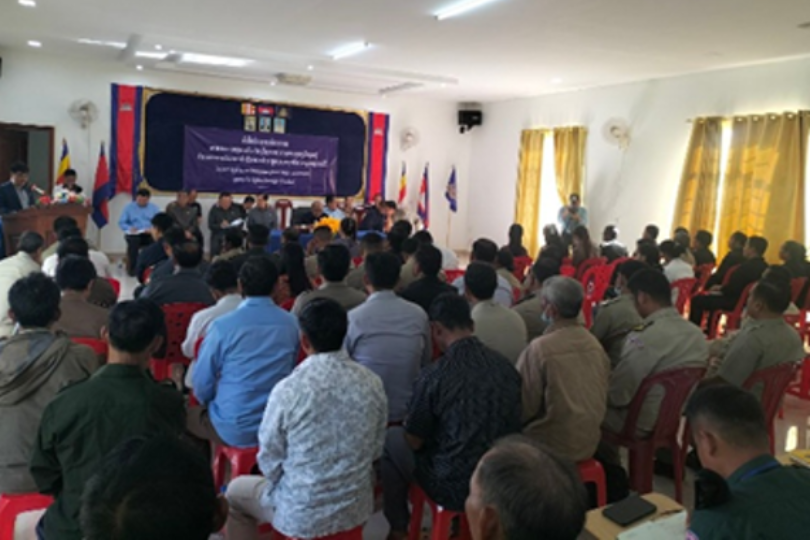
The Bounorng Indigenous community of Pu Treng village in Mondulkiri Province, home to 179 households and 733 residents, has long worked to safeguard its ancestral lands within the Keo Seima Wildlife Sanctuary.
Recognized by both the Ministry of Interior and the Ministry of Rural Development, Pu Treng initiated its Indigenous Communal Land Title (ICLT) process in 2012.
The indigneous community submitted formal documentation, including internal statutes, maps, and a recognized management structure, covering 1,338.69 hectares of communal land.
Determined to secure land titles and protect against encroachment, Pu Treng CLT, with support from My Village Organization (MVi) and other CSOs, pushed forward the ICLT process.
On September 13, 2024, a landmark meeting was held with the governor of Mondulkiri and three key departments—Land Management, Environment, and Forestry & Fisheries—to accelerate the public display for Pu Treng and neighboring Pou Leh communities.
The public display marked a major milestone. Community members carefully reviewed land information for accuracy, identified missing plots, and formally requested their inclusion.
A follow-up discussion on January 15, 2025, with the Department of Land Management addressed these concerns.
To resolve the outstanding issues, MVi in collaboration with other CSOs, committed to assisting the community in verifying the missing land titles.
Responding to this effort, the Department of Land Management scheduled verification of nine remaining plots, starting in April 2025.

Donor : USAID
Project : Youths’ Action for Biodiversity Conservation (YABC)
Activity: Training on SBSS and Theme I on Reduction of Luxury Wood Furniture Consumption
Date : March 27 – May 15, 2022
Recognizing that threats to forests, wildlife and biodiversity are the most important issues in the eastern landscape of Cambodia. My Village is an NGO that carries out a number of activities to conserve natural resources by empowering indigenous communities such as protected area communities, ethnic women’s networks, and ethnic youth networks.
Project of Youths’ Action for Biodiversity Conservation (YABC) focus on youth participation to increase the capacity for widespread dissemination of forests, wildlife, biodiversity and the environment, especially to local communities effectively.
Through the above issues, My Village Organization organized a training course on: “Reduction of Luxury Wood Furniture Consumption” for 13-school youth in the target area of Mondulkiri province for youths. The purpose of this training is to
– Increase awareness of the benefits of forests and biodiversity
– Raise awareness of the impact of using luxury wood furniture
– Increase the positive attitude of the participants and share it with their friends, family as well as through Social and Behaviour Change Communication (SBCC)
A total of 325 youths (226 women) and 159 indigenous youth (116 women) participated. Through pre-testing the ability of youths, we observed that we provided the training, only about 43 percentage have an understanding of the forest and luxury wood furniture. In contrast, after they received the training from My Village Organization on: “Reduction of Luxury Wood Furniture Consumption”, they can learn more about the forest, as well as the problem of furniture made from luxury wood up to 80 percentage. In addition, they committed to reduce of using the furniture made of luxury wood from day to day, as well as to share the knowledge they gained from this training to share to their families, relatives, friends and the community as much possible. Furthermore, they also gained a lot positive thinking and how to talk about forest issues and luxury wood furniture to their relatives, families, friends and community for reduction of luxury wood consumption and forest and biodiversity conservation. The methods that have been successfully implemented in this training course include group discussion, presentation, Q&A, watching educational videos and role play which can encourage they to reduce shyness or fear to express themselves, especially the performance from role play helped the youths to remember and better understand the relationship between the forest and luxury wood furniture.
***Note: For scoring the test of youth’s ability before and after the training, use the evaluation level of five numbers, the lowest score is represented as number 1 and the highest score is represented as number 5. Thank you!
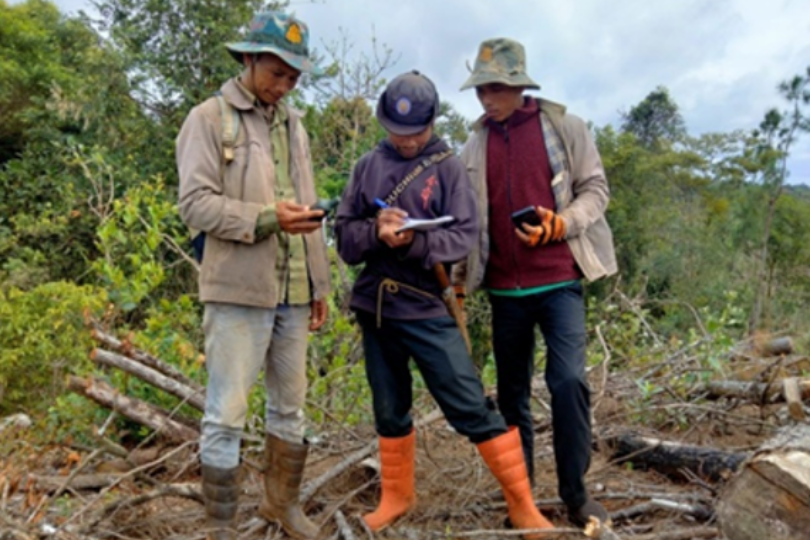
In Pu Treng village, Dak Dam commune, Mondulkiri province, Bournorng Indigenous community continues to protect its ancestral heritage and lands through collective governance rooted in tradition.
With a population of 108 households and 532 members, including 274 women, the community practices rotational farming and sustainable forest use while preserving cultural spaces for ceremonies, music, and spiritual worship.
Despite formal recognition of their Indigenous identity by the Ministry of Rural Development and Interior in 2014, the community’s journey toward securing its Indigenous Communal Land Title (ICLT) faced significant obstacles.
Though an application for collective land registration was submitted in 2017—covering 1,338.69 hectares—prolonged government delays led to rising land encroachment and frustration. Some households even withdrew from the ICLT process out of disillusionment.
In response, My Village Organization (MVi) and supporting NGOs partnered with the community to revive the ICLT efforts.
Together, they reviewed and updated legal documentation, restructured the ICLT committee, and facilitated community engagement with authorities from village to provincial levels. This renewed momentum helped address encroachment issues, revalidate land boundaries, and strengthen the community’s legal standing.
By the end of 2024, these efforts yielded tangible results. The Mondulkiri Provincial Department of Land Management conducted a public display—signaling the final procedural step toward issuing the ICLT certificate. Community representative Mr. Chren expressed hope and gratitude: “Thanks to MVi and donors for their continued support. I believe our land rights will soon be formally secured.”

Donor: USAID
Project: Youths’ Action for Biodiversity Conservation (YABC)
Activity: Educational Video on I can speak up and support and persuade my friends and family to save forests from not Purchasing Luxury Wood Furniture
Date: March 28, 2022
My Village Organization (MVi) has organized three online campaigns through Online Community Center (OCC) Facebook Page on demand reduction for luxury wood furniture, reducing bushmeat consumption and stopping littering. These campaigns were conducted to increase the understanding and knowledge about the negative impacts of bushmeat consumption, luxury wood furniture and littering on biodiversity, forests, environment and human health and to increase the participation of citizens to support and take positive action for the purpose of reducing bushmeat consumption and demand for luxury wood furniture and stopping littering.
The video below is part of a campaign to Demand Reduction for Luxury Wood Furniture, which will highlight the benefits of forests, the destruction of natural resources through the use of luxury wood furniture, and youth participation to reduce the use of furniture made of luxury wood.
.
#TogetherForCambodianForest
#SayNoLuxuryWoodFurniture
#SayNoDamageForest
Facebook Page Link: https://www.facebook.com/OCCMVi
Facebook Name: Online Community Center
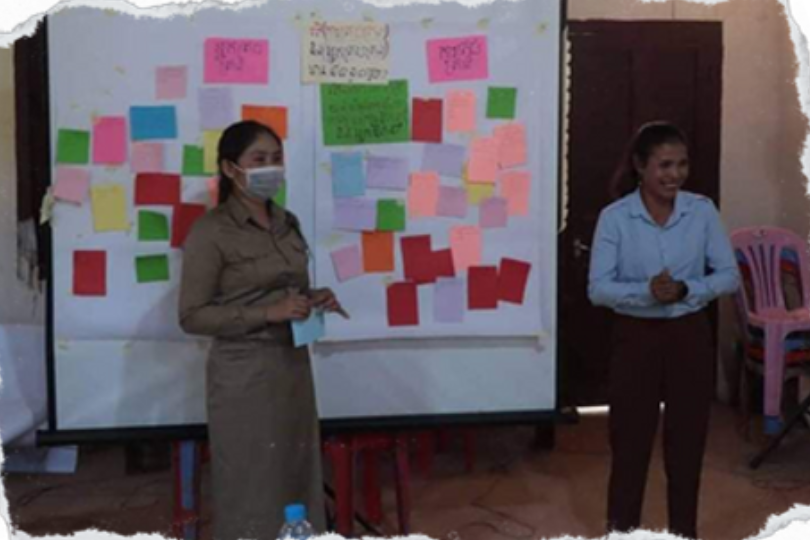
In Thboung Kla village, O’maras commune, Stung Treng province, Mrs. Khun Sothy has emerged as a determined voice for grassroots development. A mother of four and member of an agricultural community, she once lived a quiet life farming and growing vegetables. But her journey took a meaningful turn when local authorities recognized her active participation and selected her as a community women’s leader.
Initially, Mrs. Sothy faced self-doubt and limited experience in leadership. “At first, I didn’t know how to lead women’s groups or organize meetings,” she recalled. That changed when she received capacity-building support from My Village Organization (MVi), including training on gender action learning, leadership, decision-making, and community mobilization.
Equipped with new skills, Mrs. Sothy began holding meetings to share knowledge and mobilize Indigenous Peoples, persons with disabilities, youth, and women to engage in outreach activities. She led issue-collection discussions in her community and represented them in monthly commune council meetings, ensuring their voices influenced the village development plan.
Her growth wasn’t just personal—it was catalytic. Her efforts sparked wider community participation in development planning, especially among women and underrepresented groups. Through partnerships with fishery communities and local authorities, she promoted sustainable resource management and advocated for communal needs.“
“I want to urge all women to be brave and willing to work,” she said. “Even if it doesn’t bring income, everyone has the right to participate in developing our village and protecting our fisheries.”

Donor: USAID
Project: Youths’ Action for Biodiversity Conservation (YABC)
Activity:Educational Video on Purchasing Luxury Wood Furniture Would mean that you are contributing to the loss of Cambodia’s beautiful forest
Date: March 28, 2022
My Village Organization (MVi) has organized three online campaigns through Online Community Center (OCC) Facebook Page on demand reduction for luxury wood furniture, reducing bushmeat consumption and stopping littering. These campaigns were conducted to increase the understanding and knowledge about the negative impacts of bushmeat consumption, luxury wood furniture and littering on biodiversity, forests, environment and human health and to increase the participation of citizens to support and take positive action for the purpose of reducing bushmeat consumption and demand for luxury wood furniture and stopping littering.
The video below is part of a campaign to Demand Reduction for Luxury Wood Furniture, which will highlight the benefits of forests, the destruction of natural resources through the use of luxury wood furniture, and the disadvantages deforestation.
#TogetherForCambodianForest
#SayNoLuxuryWoodFurniture
#SayNoDamageForest
Facebook Page Link: https://www.facebook.com/OCCMVi
Facebook Name: Online Community Center
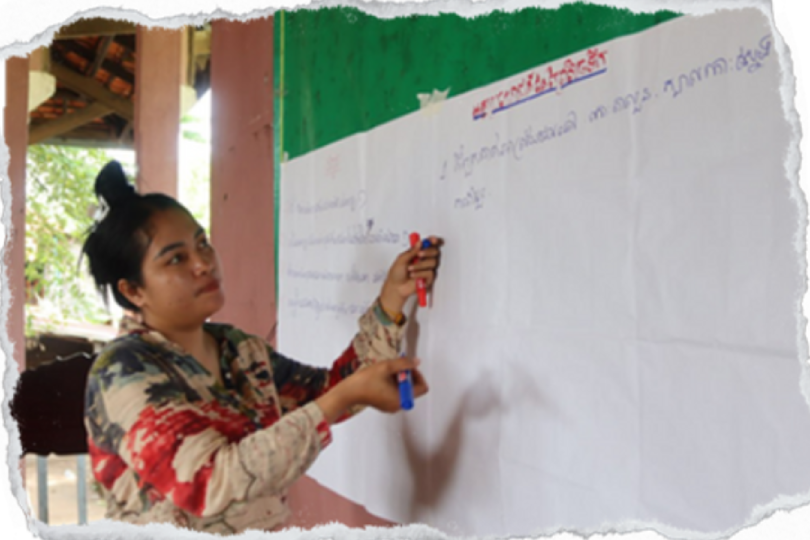
In Koh Sneang village, Stung Treng Province, 26-year-old Mrs. Kon Somdon, a mother of two, has emerged as a dynamic force in community-led climate action. As the women’s group chief, she initially had limited understanding of climate change and its impacts. But through her involvement in the Vulnerability and Risk Assessment (VRA) initiative, her perspective and leadership were transformed.
The VRA process introduced her to critical climate concerns facing her village, including shifting weather patterns, rising water levels, and frequent extreme weather events. Equipped with new knowledge, Mrs. Somdon convened village meetings to discuss climate threats and adaptation strategies. Her leadership ensured that the needs of women, people with disabilities, LGBTQI+ individuals, and children were integrated into local adaptation planning.
Capacity-building workshops boosted her confidence and skills, enabling her to actively shape the development of inclusive climate action plans. Recognizing her effectiveness, she was selected to advocate for climate priorities in the Koh Sneang Commune Investment Program (CIP). With determination and community support, she championed the inclusion of climate-resilient projects such as early warning systems (App 1294), installation of flood-level billboards, water-level measurement poles, and climate-smart agriculture.
Mrs. Somdon’s impact extended beyond her village. She began participating in district and provincial dialogues, ensuring grassroots perspectives were heard in broader climate policymaking. Her advocacy helped place community resilience at the center of subnational development agendas.
Her story underscores the power of inclusive leadership and knowledge-sharing. From hesitant participant to respected advocate, Mrs. Kon Somdon has played a pivotal role in transforming climate resilience in Koh Sneang. Her journey serves as an inspiration for other women seeking to shape development priorities from the ground up.

Donor : USAID
Project : Youths’ Action for Biodiversity Conservation (YABC)
Activity: Training on SBCC and Theme I on Reduction of Luxury Wood Furniture Consumption
Date : March 27 – May 15, 2022
Recognizing that threats to forests, wildlife and biodiversity are the most important issues in the eastern landscape of Cambodia. My Village is an NGO that carries out a number of activities to conserve natural resources by empowering indigenous communities such as protected area communities, ethnic women’s networks, and ethnic youth networks.
Project of Youths’ Action for Biodiversity Conservation (YABC) focus on youth participation to increase the capacity for widespread dissemination of forests, wildlife, biodiversity and the environment, especially to local communities effectively.
Through the above issues, My Village Organization organized a training course on: “Reduction of Luxury Wood Furniture Consumption” for 13-school youth in the target area of Mondulkiri province for youths. The purpose of this training is to
– Increase awareness of the benefits of forests and biodiversity
– Raise awareness of the impact of using luxury wood furniture
– Increase the positive attitude of the participants and share it with their friends, family as well as through Social and Behaviour Change Communication (SBCC)
A total of 325 youths (226 women) and 159 indigenous youth (116 women) participated. Through pre-testing the ability of youths, we observed that we provided the training, only about 43 percentage have an understanding of the forest and luxury wood furniture. In contrast, after they received the training from My Village Organization on: “Reduction of Luxury Wood Furniture Consumption”, they can learn more about the forest, as well as the problem of furniture made from luxury wood up to 80 percentage. In addition, they committed to reduce of using the furniture made of luxury wood from day to day, as well as to share the knowledge they gained from this training to share to their families, relatives, friends and the community as much possible. Furthermore, they also gained a lot positive thinking and how to talk about forest issues and luxury wood furniture to their relatives, families, friends and community for reduction of luxury wood consumption and forest and biodiversity conservation. The methods that have been successfully implemented in this training course include group discussion, presentation, Q&A, watching educational videos and role play which can encourage they to reduce shyness or fear to express themselves, especially the performance from role play helped the youths to remember and better understand the relationship between the forest and luxury wood furniture.
***Note: For scoring the test of youth’s ability before and after the training, use the evaluation level of five numbers, the lowest score is represented as number 1 and the highest score is represented as number 5. Thank you!
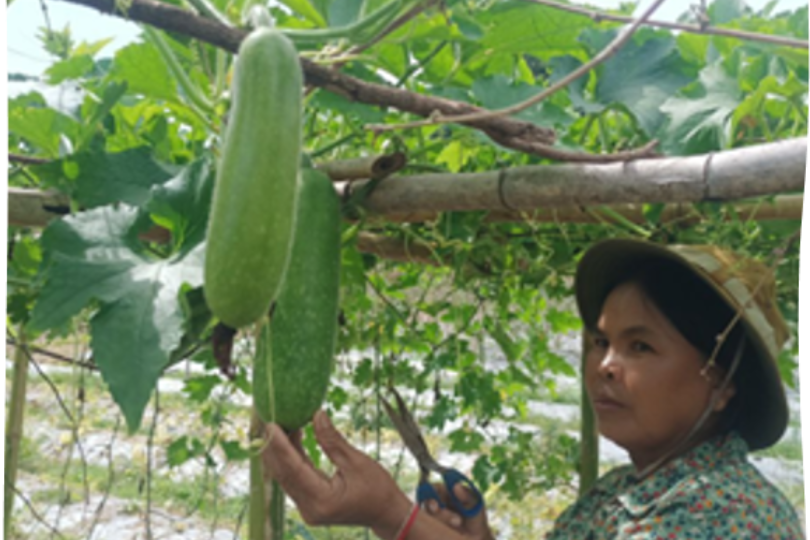
In the riverine village of Koh Sralao, Stung Treng province, 52-year-old Mrs. Loeur Sin has emerged as a role model for women in agriculture and climate resilience. Living 35 kilometers from Stung Treng town and accessible only by boat, her community thrives on farming, fishing, and forest resources.
Among them, Mrs. Sin stands out as a leading agricultural promoter formed by My Village Organization (MVi), actively engaging in climate discussions and community development initiatives.
With technical support from MVi, Sin adopted the climate-smart agriculture (CSA) model, transforming her home garden into a diversified source of income and climate adaptation.
In 2024, she cultivated a range of vegetables including peppers, eggplant, cucumbers, and lettuce. Harvesting 10–20 kilograms each session, she supplies about 225 kilograms weekly to local buyers at the Mekong Bird Resort, earning approximately 337,500 riels per week.
Notably, she also collects produce from fellow farmers, strengthening local networks and livelihoods.
Beyond her economic success, Sin is passionate about empowering other women and youth. “They can do the same as I do,” she shared. “It’s about creating income and increasing our voices in community development.” Her learning journey—supported by MVi and Oxfam—deepened her understanding of gender equality and inclusive climate adaptation.
Yet, challenges persist. Women’s voices in decision-making remain limited due to heavy workloads and poor access to climate information. Sin stresses that women must play central roles in disaster risk reduction and climate resilience, engaging with institutions like CCDM, DCDM, and RUA to strengthen village planning.
Today, Mrs. Sin is not only a producer but also a speaker, sharing best practices in workshops and mentoring others. Her leadership reflects the potential of grassroots women to drive inclusive, climate-smart agriculture across Cambodia’s vulnerable landscapes.